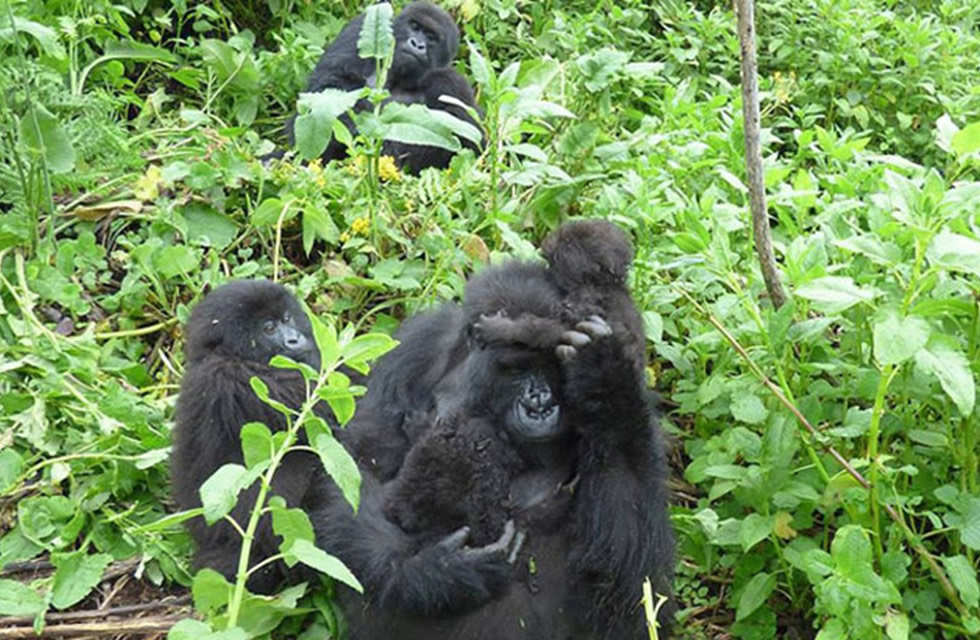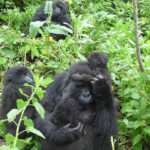Whereas Rwanda may not be the best wildlife safari destination like Kenya and South Africa, its flourishing niche visitor sector has positioned it on the world map. A safari to the Northwestern part of the country to Volcanoes National Park Rwanda rewards travelers with exceptional encounters with the rarest and world’s largest primate “mountain gorillas.” Often described as a “lifetime” experience, trekking the rare mountain gorillas in Rwanda is an absolute wildlife adventure, a reason why thousands of trekkers have time and again spent their safari holidays in this small landlocked country.
Ideally, spending 1 hour with gorillas in the wild shouldn’t be missed by any primate enthusiasts in the world! If you have ever heard or read a story about the world’s famous primatologist “Dian Fossey,” certainly it is a high time you achieved that long-time dream in the jungles of Volcanoes National Park, Northwestern Rwanda. Dian Fossey attracted the world’s attention to the plight of these endangered Apes in the 1960s when they were only about 250 individuals in the entire world. Currently, the world boasts of nearly 900 mountain gorillas that are divided between Rwanda, Uganda and the Democratic Republic of Congo with about 380 individuals protected in the lush tropical rainforest of Rwanda’s Volcanoes National Park.
Africa’s exceptional conservation success stories, are dependent on the thriving of mountain gorillas, and thanks to tourism that has greatly done its part too. Rwanda is rated as one of the ideal tourist destinations for gorilla trekking tours. Tracking comes at a cost, but the 1 (one) hour magical experience with these charismatic wild creatures in their natural habitat is incomparable! The famous tea-growing nation today is greatly reaping from its mountain gorillas and it is undoubtedly that the country’s foreign currency earnings have increased.
Recently, the Rwanda Development Board increased the price of gorilla permits on 6th May 2017 for trekkers to view the endangered primates. The current price for gorilla trekking permits stands at $1500 for all visitors. The aim of revising the tariffs was primarily to ensure the long-term sustainability of the endangered species whose lives are highly at risk of extinction.
Rwanda’s mountain gorillas are the most sought-after and researched wildlife species in the world today. They share about 98% of their DNA with humans, something that makes them the most susceptible primates to human infectious diseases. For the last decades, Rwanda’s research data still provides critical insights into gorilla protection needs. With the increase in the number of mountain gorillas in the wild, chances are, a large number of trekkers will be attracted to gorilla destinations. This means that there will be an increase in interaction between gorilla families and visitors which largely exposes these endangered species.
Despite the large revenues from trekkers, gorilla protection and conservation is also very critical not only in Rwanda but also in Uganda and the Democratic Republic of Congo. Mountain gorillas still remain the world’s most critically endangered species, and are very crucial to minimize the number of people visiting a gorilla family per day to ensure their long-term future in the wild.
The previous year, Rwanda’s current account deficit expanded as shipment earnings from minerals like cassiterite that make up 14% of total exports, declined 27% due to lower global commodities prices. The shortfall more than doubled from 5 years before $1.2 billion in 2016. The country’s projects exports are estimated to increase by a 5th this year after increasing about 40% in the first 2 months of 2017.
Tourism is Rwanda’s largest foreign exchange earner and contributes nearly 11% to the $8 billion economy. The mountain gorillas that also wander around the jungles of Virunga Mountain ranges that extend Rwanda together with neighboring Uganda and the Democratic Republic of Congo make up the country’s largest tourist attraction.
Limited gorilla permits
There are only 80 single gorilla trekking permits that are available each day for trekkers to visit the gorilla family. This translates to 8 visitors per permit and 10 gorilla groups that have been habituated for gorilla tourism in Volcanoes National Park. Even Rwandans who used to purchase trekking permits at only 30000 francs ($360), to view the rare mountain gorillas are now required to buy a permit using the current cost. This also includes the East African residents who before also paid $300. Rwanda that sold 22,219 gorilla permits in 2016 prefers a low volume and high-value market. The demand from travelers, therefore, indicates that Rwanda isn’t a massive number of tourist destinations mainly for gorilla tracking. However, the prompt doubling risks losing important revenue for both the sector and the government and the Rwanda Tour and Travel Association explained.
In conclusion, gorilla tourism is the backbone of the growing tourism sector in Rwanda given the fact that thousands of trekkers are attracted each year for magical experiences in the jungles of Volcanoes National Park. Large numbers of visitors mean increased foreign exchange earnings which improve the nation’s economy. It also empowers local communities around the park economically through revenue schemes whereby tourism revenue is used to finance development projects that have and still contributing largely to conservation practices. The revenue-sharing scheme for Rwanda was increased by Rwanda Development Board from 5% to 10% on 6th May 2017.


